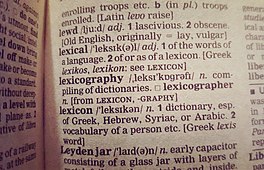Documentation:RelLex/A Mitsqanaqan̓ Ventureño — English, English — Mitsqanaqan̓ Ventureño Dictionary
A Mitsqanaqan̓ Ventureño — English, English — Mitsqanaqan̓ Ventureño Dictionary
| Relational Lexicography Knowledgebase | |
|---|---|

| |
| About RelLex | |
| An index of under-resourced North American language references, including print and digital dictionaries. | |
| Browse by | |
| About the Knowledgebase | |
| Find our filterable Knowledgebase of dictionaries and lexicography technology at https://knowledgebase.arts.ubc.ca/. | |
Language Name
Ventureño.
Alternate Language Names
Central Chumash, Mitskanaxan.
Region
California, United States.
Who
Timothy Henry-Rodriguez.
Others Involved
Eleanor Arellanes Fishburn, Brenda “Cookie” Guzman, Isabel Layton, Julie Tumamait-Stenslie, Matthew Vestuto (Cultural Consultants); Kenneth Whistler (Technical Assistance); Kirstina Kroger, Daniela De la Parra, Risa Erskine, Avelino Corral Esteban, Sorina Dragusanu, Klara Kim, Ajuawak Kapashesit, Julia Quinn, Bhara Taşören, Kaveh Vee, Victoria Winsryg, Sophie Villerius, Karen Wiecha (Research Team I); Abigail Hansell, Kevin Orbach, Edita Ghushchyan, Marti McClure (Research Team II); Fernando Librado (Kitsepawit, Candelaria Valenzuela, Cecilio (Tumamait), Juan de Jesús Justo, Simplicio Pico (Pamashikimait), José Peregrino Romero (Winay), Alejandro López, José Juan Olivas, the del Campos (Speakers); Veronica Muñoz Ledo-Yañez, David Green, and David Rodriguez-Henry (Spanish translation assistants); Marianne Mithun and Wallace Chafe (design); Suzanne Wash (language consultant); Martha Macri (Harrington notes); National Science Foundation (support); National Endowment for the Humanities (funding).
Publishing Information
This work was published in 2019, and is part of the University of Hawaii’s Kaipuleohone digital ethnographic archive.
How People are Cited
Cultural consultants, research assistants, and speakers are cited in the Post-Title section. Consultants are cited in the Preface, and speakers are cited in About the Speakers.
How Information is Cited
Previous works used to compile this dictionary are cited in the Bibliography.
Where is Information Coming from
Entries and cultural information in this dictionary come from speakers and previous works, particularly work from the John Peabody Harrington Archives. Harrington was a linguist and anthropologist who conducted extensive fieldwork with the Indigenous peoples of California from 1907 to 1957.
Tools and Framework used
This dictionary is available as a digital book (PDF).
Access
The digital book (PDF) is open access online and can be downloaded from the University of Hawaii’s Kaipuleohone digital ethnographic archive.
Included Languages and Directionality
Mitsqanaqan̓ Ventureño to English, English to Mitsqanaqan̓ Ventureño. Cognates from other Chumashan languages are included in some entries, and are listed with there three letter ISO codes.
Dialects Included
This is primarily a dictionary of the Mitsqanaqan̓ dialect. Occasional forms are included from Matilija, Ojai, Xom̓ (Castaic), Humaliwo, Muwu, and sʼoməs dialects and are marked as such in entries. Forms from the Mitsqanaqan̓ dialect are unmarked.
Type of Dictionary
This is a bilingual, bidirectional dictionary.
How are Entries Organised
A guide to the information included in each entry can be found on p. 33. Entries in the Ventureño to English section are organised alphabetically by Ventureño headword. Each entry lists variant and reduplicated forms of the headword (if applicable), its part of speech, a practical English translation, as well as in most entries: example sentences, etymological information, cognates from other Chumashan languages, and the source of the etymological and cognate information. Many entries contain the headword's parsed form (separated by morpheme) and paradigms. Dialects are marked when the entry comes from a dialect other than Mitsqanaqan̓.
The English to Ventureño section is much shorter. It is organised alphabetically by English headword, like the previous section, and each entry contains the Ventureño equivalent in boldface.
Towards the back of the dictionary is a section entitled Semantic Lists. These are wordlists organised alphabetically by English followed by Ventureño equivalent and grouped by theme: Animals, Basketry, Body Parts, Borrowings, Geography, Food and Eating, Kinship (Family), Plants and Agriculture, Telling Time (Chronometry), Tools and Useful Items, and Weather (Meteorology).
Other Features
| Feature | Included | More Information |
|---|---|---|
| Guide to use and understand | ✅ | |
| Audio | ❌ | |
| Images | ❌ | |
| Example phrases | ✅ | In most entries |
| Speakers marked | ❌ | |
| Dialects marked | ✅ | When entries are not from the Mitsqanaqan̓ dialect, dialect is marked in entries |
External Links
Reference on Scholar Space: https://scholarspace.manoa.hawaii.edu/collections/bf4ed241-69d9-477a-81a3-1605d499316f
The open access PDF of this dictionary can be downloaded from the University of Hawaii’s Kaipuleohone digital ethnographic archive:https://scholarspace.manoa.hawaii.edu/server/api/core/bitstreams/f773aee2-a4dc-439d-b2d0-baeae669b413/content